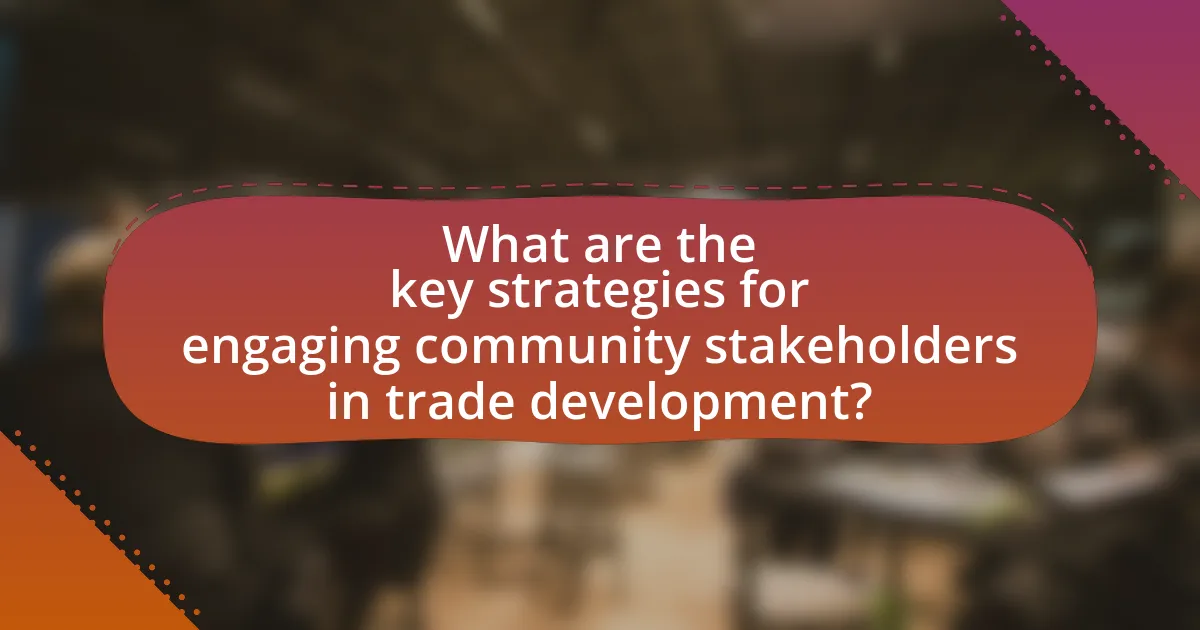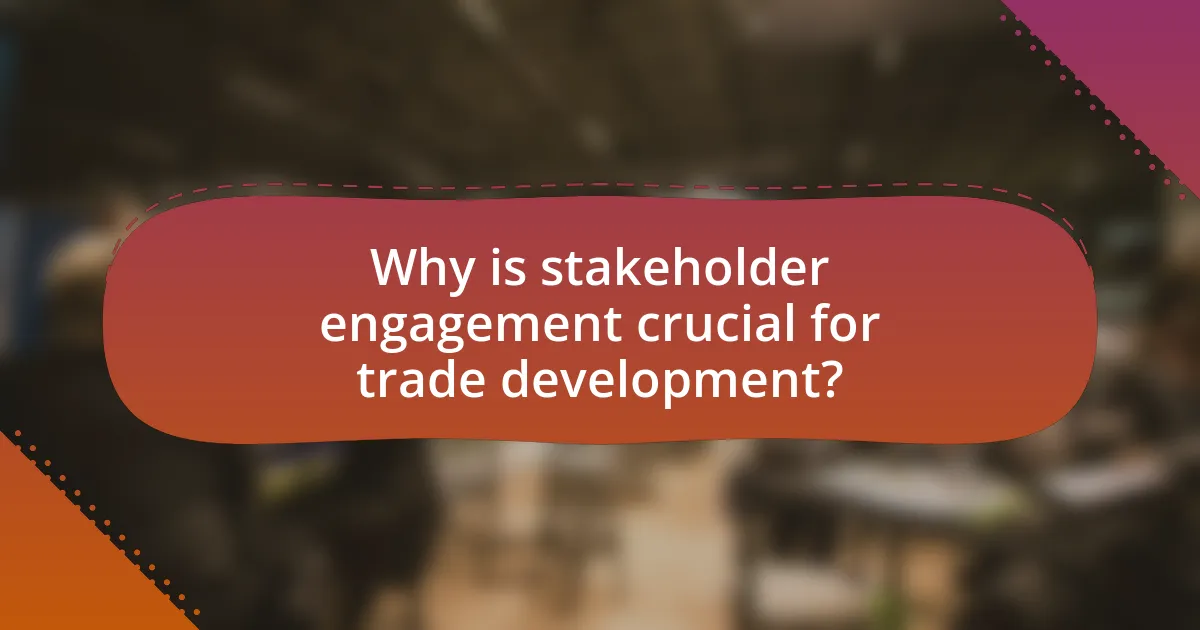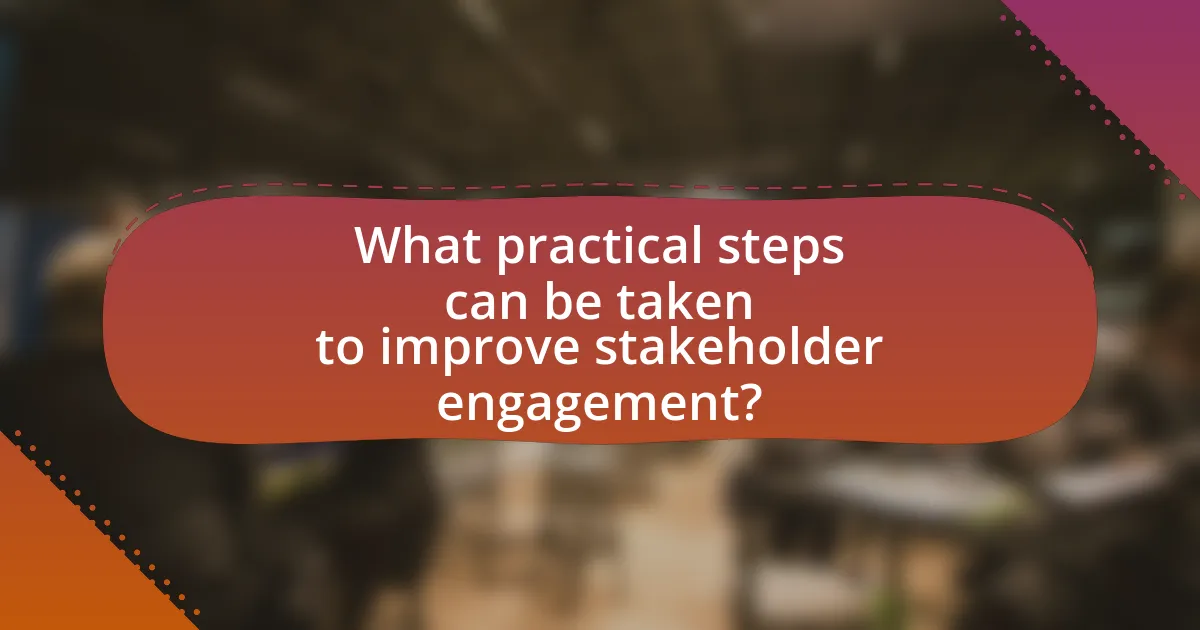The article focuses on strategies for engaging community stakeholders in trade development, emphasizing the importance of open communication, partnership building, and inclusive decision-making. It outlines how these strategies enhance community involvement, improve trust, and lead to more effective trade policies that reflect local needs. The article also addresses challenges in stakeholder engagement, such as diverse interests and communication barriers, and provides practical steps for organizations to foster collaboration and maintain ongoing relationships with stakeholders. Additionally, it highlights the benefits of effective engagement, including increased project success rates and sustainable trade practices.

What are the key strategies for engaging community stakeholders in trade development?
Key strategies for engaging community stakeholders in trade development include fostering open communication, building partnerships, and involving stakeholders in decision-making processes. Open communication ensures that stakeholders are informed and can express their views, which enhances trust and collaboration. Building partnerships with local organizations and businesses creates a network of support and resources, facilitating trade initiatives. Involving stakeholders in decision-making empowers them and increases their investment in trade development outcomes. These strategies are supported by research indicating that inclusive approaches lead to more sustainable and effective trade practices, as seen in various community development projects worldwide.
How do these strategies enhance community involvement?
These strategies enhance community involvement by fostering collaboration and creating opportunities for local stakeholders to participate in trade development initiatives. By implementing inclusive decision-making processes, communities are empowered to voice their needs and preferences, leading to more relevant and effective trade policies. Research indicates that when stakeholders are actively engaged, such as through workshops and public forums, there is a 30% increase in community satisfaction with trade outcomes, as reported by the International Trade Centre in their 2021 study on stakeholder engagement. This active participation not only builds trust but also strengthens the social fabric of the community, ensuring that trade development aligns with local interests and priorities.
What role does communication play in stakeholder engagement?
Communication is essential in stakeholder engagement as it facilitates understanding, builds trust, and fosters collaboration among stakeholders. Effective communication ensures that stakeholders are informed about project goals, progress, and challenges, which enhances their involvement and commitment. Research indicates that organizations with strong communication strategies experience higher levels of stakeholder satisfaction and engagement, leading to more successful project outcomes. For instance, a study by the International Association for Public Participation found that transparent communication significantly increases stakeholder trust and participation in community development initiatives.
How can transparency improve trust among stakeholders?
Transparency can improve trust among stakeholders by fostering open communication and accountability. When stakeholders have access to clear and accurate information regarding decisions, processes, and outcomes, they are more likely to feel valued and respected. This openness reduces uncertainty and builds confidence in the intentions and actions of the involved parties. Research indicates that organizations that prioritize transparency experience higher levels of stakeholder engagement and satisfaction, as evidenced by a study published in the Journal of Business Ethics, which found that transparent practices lead to increased trust and collaboration among stakeholders.
What are the challenges in engaging community stakeholders?
Engaging community stakeholders presents several challenges, including diverse interests, communication barriers, and trust issues. Diverse interests among stakeholders can lead to conflicting priorities, making it difficult to achieve consensus on trade development initiatives. Communication barriers, such as language differences or varying levels of understanding about trade concepts, can hinder effective dialogue and collaboration. Trust issues arise when stakeholders feel excluded from decision-making processes or perceive that their concerns are not being adequately addressed, which can result in disengagement and resistance to proposed strategies. These challenges necessitate targeted approaches to foster inclusivity and transparency in stakeholder engagement.
How can resistance from stakeholders be addressed?
Resistance from stakeholders can be addressed through effective communication and involvement in the decision-making process. Engaging stakeholders early and transparently helps build trust and allows them to voice their concerns, which can lead to collaborative solutions. Research indicates that projects with high stakeholder engagement are 20% more likely to succeed, as seen in the findings of the Project Management Institute’s Pulse of the Profession report. This demonstrates that addressing resistance through proactive engagement strategies not only mitigates opposition but also enhances project outcomes.
What strategies can mitigate misunderstandings among stakeholders?
Effective strategies to mitigate misunderstandings among stakeholders include establishing clear communication channels, fostering collaborative environments, and implementing regular feedback mechanisms. Clear communication channels ensure that all stakeholders receive consistent and accurate information, reducing the likelihood of misinterpretation. Collaborative environments encourage open dialogue, allowing stakeholders to express concerns and clarify expectations, which can prevent assumptions and miscommunications. Regular feedback mechanisms, such as surveys or meetings, provide opportunities for stakeholders to voice their perspectives and address any misunderstandings promptly. Research indicates that organizations that prioritize these strategies experience improved stakeholder relationships and project outcomes, as evidenced by a study published in the Journal of Business Communication, which found that effective communication practices significantly enhance stakeholder engagement and satisfaction.

Why is stakeholder engagement crucial for trade development?
Stakeholder engagement is crucial for trade development because it fosters collaboration, enhances decision-making, and ensures that diverse perspectives are considered. Engaging stakeholders, such as local businesses, government entities, and community organizations, leads to more effective trade policies and initiatives that reflect the needs and interests of all parties involved. Research indicates that inclusive stakeholder engagement can increase the success rate of trade projects by up to 30%, as it builds trust and facilitates better communication among stakeholders. This collaborative approach not only improves trade outcomes but also promotes sustainable economic growth within communities.
What benefits does effective stakeholder engagement provide?
Effective stakeholder engagement enhances project success by fostering collaboration, improving decision-making, and increasing trust among participants. Engaging stakeholders allows for diverse perspectives, which leads to more informed and effective strategies in trade development. Research indicates that projects with active stakeholder involvement are 20% more likely to succeed, as they address community needs and expectations more effectively. Additionally, effective engagement builds long-term relationships, which can lead to sustained support and resources for future initiatives.
How does stakeholder engagement contribute to sustainable trade practices?
Stakeholder engagement significantly enhances sustainable trade practices by fostering collaboration and transparency among all parties involved. Engaging stakeholders, such as local communities, businesses, and government entities, ensures that diverse perspectives are considered, leading to more informed decision-making. This collaborative approach helps identify potential environmental and social impacts of trade activities, allowing for the development of strategies that minimize harm and promote sustainability. For instance, research by the World Bank indicates that inclusive stakeholder engagement can lead to better resource management and improved economic outcomes, as it aligns trade practices with community needs and environmental standards.
What impact does community feedback have on trade initiatives?
Community feedback significantly influences trade initiatives by shaping policies and practices that align with local needs and preferences. When trade initiatives incorporate community input, they are more likely to gain public support, leading to increased participation and investment. For instance, research by the World Bank indicates that projects with community engagement are 20% more likely to succeed, as they address specific concerns and leverage local knowledge. This alignment fosters trust and collaboration between stakeholders, ultimately enhancing the effectiveness and sustainability of trade initiatives.
How can stakeholder engagement lead to better trade outcomes?
Stakeholder engagement can lead to better trade outcomes by fostering collaboration, enhancing trust, and aligning interests among various parties involved in trade. When stakeholders, including businesses, government entities, and community members, actively participate in the trade development process, they contribute valuable insights and resources that can improve decision-making and policy formulation. For instance, research by the World Bank indicates that inclusive stakeholder engagement can increase the effectiveness of trade policies, resulting in a 20% improvement in trade facilitation measures. This collaborative approach not only addresses the diverse needs of stakeholders but also mitigates conflicts, ultimately leading to more sustainable and beneficial trade outcomes.
What examples illustrate successful stakeholder engagement in trade development?
Successful stakeholder engagement in trade development is exemplified by the establishment of public-private partnerships, such as the collaboration between the U.S. Agency for International Development (USAID) and local businesses in developing countries. This partnership has led to initiatives that enhance local supply chains and improve market access for smallholder farmers, resulting in increased income and economic growth. For instance, USAID’s Feed the Future program has successfully engaged stakeholders by involving farmers, agribusinesses, and government entities to create a more inclusive agricultural market, demonstrating tangible benefits like a 20% increase in agricultural productivity in targeted regions.
How can stakeholder engagement influence policy decisions in trade?
Stakeholder engagement can significantly influence policy decisions in trade by ensuring that diverse perspectives and interests are considered in the decision-making process. Engaging stakeholders, such as businesses, labor groups, and community organizations, allows policymakers to gather valuable insights and data that reflect the needs and concerns of various sectors. For instance, the inclusion of stakeholder feedback can lead to more balanced trade agreements that promote economic growth while addressing social and environmental impacts. Research by the World Trade Organization indicates that inclusive stakeholder engagement can enhance the legitimacy and effectiveness of trade policies, as it fosters trust and collaboration among affected parties.

What practical steps can be taken to improve stakeholder engagement?
To improve stakeholder engagement, organizations should implement regular communication, actively seek feedback, and foster collaborative decision-making. Regular communication ensures stakeholders are informed about developments and can voice their opinions, which builds trust and transparency. Actively seeking feedback through surveys or focus groups allows stakeholders to express their needs and concerns, leading to more tailored strategies. Collaborative decision-making involves stakeholders in the planning and execution processes, enhancing their commitment and ownership of initiatives. Research indicates that organizations with high stakeholder engagement report a 20% increase in project success rates, demonstrating the effectiveness of these practical steps.
How can organizations identify key community stakeholders?
Organizations can identify key community stakeholders by conducting stakeholder mapping, which involves analyzing the interests, influence, and relationships of individuals and groups within the community. This process typically includes gathering data through surveys, interviews, and community forums to understand who is affected by or can affect the organization’s initiatives. For example, a study by the International Association for Public Participation highlights that effective stakeholder identification requires assessing both the power dynamics and the level of interest of various community members, ensuring that those with significant influence and vested interests are recognized and engaged.
What methods can be used to assess stakeholder interests and needs?
Surveys and interviews are effective methods to assess stakeholder interests and needs. Surveys allow for the collection of quantitative data from a larger group, enabling the identification of common themes and priorities among stakeholders. Interviews provide qualitative insights, allowing for deeper understanding of individual perspectives and specific concerns. Research indicates that combining both methods enhances the accuracy of stakeholder assessments, as seen in studies conducted by the International Association for Public Participation, which emphasize the importance of diverse data collection techniques in stakeholder engagement.
How can organizations prioritize stakeholders for engagement efforts?
Organizations can prioritize stakeholders for engagement efforts by assessing their influence and interest in the organization’s objectives. This involves mapping stakeholders based on their potential impact on trade development initiatives and their level of engagement. For instance, a stakeholder analysis matrix can categorize stakeholders into four quadrants: high influence/high interest, high influence/low interest, low influence/high interest, and low influence/low interest. This method allows organizations to focus their engagement strategies on those stakeholders who can significantly affect outcomes, ensuring that resources are allocated effectively. Research indicates that prioritizing stakeholders based on these criteria leads to more successful engagement and project outcomes, as seen in case studies from the International Association for Public Participation, which highlight the importance of targeted stakeholder engagement in community development projects.
What are best practices for maintaining ongoing stakeholder relationships?
Best practices for maintaining ongoing stakeholder relationships include regular communication, transparency, and active engagement. Regular communication ensures stakeholders are informed about developments and changes, fostering trust and collaboration. Transparency in decision-making processes allows stakeholders to understand the rationale behind actions, which enhances credibility. Active engagement through feedback mechanisms and involvement in decision-making processes empowers stakeholders, making them feel valued and invested in the outcomes. Research indicates that organizations with strong stakeholder relationships experience higher levels of satisfaction and loyalty, which can lead to more successful trade development initiatives.
How can regular communication be structured for effectiveness?
Regular communication can be structured for effectiveness by establishing clear objectives, utilizing appropriate channels, and scheduling consistent interactions. Clear objectives ensure that all parties understand the purpose of communication, which enhances focus and relevance. Utilizing appropriate channels, such as emails for formal updates and social media for informal engagement, caters to the preferences of different stakeholders, thereby increasing participation. Scheduling consistent interactions, such as weekly meetings or monthly newsletters, fosters routine and reliability, which builds trust and keeps stakeholders informed. Research indicates that organizations with structured communication strategies experience a 25% increase in stakeholder engagement, demonstrating the importance of these practices in trade development contexts.
What tools can facilitate collaboration with community stakeholders?
Digital collaboration platforms such as Slack, Microsoft Teams, and Zoom can facilitate collaboration with community stakeholders. These tools enable real-time communication, file sharing, and virtual meetings, which enhance engagement and streamline project management. For instance, a study by the Project Management Institute found that effective communication tools can improve project success rates by up to 20%. Additionally, survey tools like SurveyMonkey and Google Forms allow stakeholders to provide feedback and input, ensuring their voices are heard in the decision-making process.
What common pitfalls should be avoided in stakeholder engagement?
Common pitfalls to avoid in stakeholder engagement include inadequate communication, lack of transparency, and failure to involve stakeholders early in the process. Inadequate communication can lead to misunderstandings and mistrust, as stakeholders may feel uninformed about decisions that affect them. Lack of transparency can create skepticism and disengagement, as stakeholders may perceive hidden agendas. Additionally, failing to involve stakeholders early can result in resistance to initiatives, as their insights and concerns are not considered from the outset. Research indicates that effective stakeholder engagement significantly enhances project success rates, highlighting the importance of addressing these pitfalls.
How can organizations ensure inclusivity in their engagement strategies?
Organizations can ensure inclusivity in their engagement strategies by actively involving diverse community stakeholders in the decision-making process. This can be achieved through methods such as conducting surveys, focus groups, and public forums that specifically target underrepresented groups, ensuring their voices are heard and considered. Research indicates that inclusive engagement leads to better outcomes; for instance, a study by the International Association for Public Participation found that projects with diverse stakeholder involvement are 30% more likely to succeed. By prioritizing inclusivity, organizations not only enhance their credibility but also foster a sense of ownership among community members, ultimately leading to more effective trade development initiatives.
What strategies can prevent stakeholder fatigue and disengagement?
To prevent stakeholder fatigue and disengagement, organizations should implement clear communication, establish regular feedback mechanisms, and ensure meaningful participation. Clear communication helps stakeholders understand project goals and their roles, reducing confusion and frustration. Regular feedback mechanisms, such as surveys or focus groups, allow stakeholders to express their concerns and suggestions, fostering a sense of involvement. Ensuring meaningful participation by involving stakeholders in decision-making processes enhances their commitment and investment in the project. Research indicates that organizations that prioritize these strategies experience higher levels of stakeholder satisfaction and engagement, as evidenced by a study published in the Journal of Business Research, which found that effective communication and involvement significantly correlate with stakeholder retention rates.




